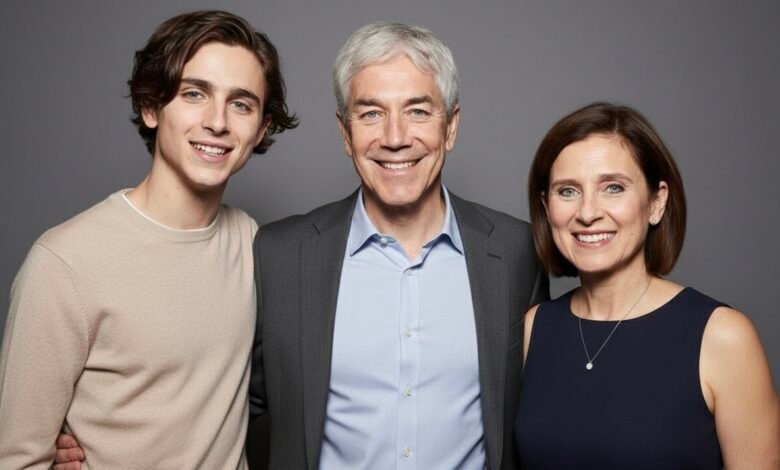Marc Chalamet: The Visionary Mind Behind a Quiet Cultural Influence
A Deep Exploration of the Life, Influence, and Cultural Legacy of Marc Chalamet

Introduction
Marc Chalamet exists within a unique cultural constellation—one defined by journalism, global communication, and a deep-rooted artistic presence that often echoes quietly behind the fame of his son, the actor Timothée Chalamet. Yet Marc’s story stands firmly on its own, shaped by a lifelong commitment to storytelling, international media, and the intricate interplay between culture and communication. His life traces a path from French origins to New York’s multicultural landscape, allowing him to embody a blend of tradition and innovation that mirrors the evolving world of modern journalism. As global narratives shift and digital literacy reshapes how stories are told, Marc Chalamet’s contributions provide a grounding force, offering insight into how one can navigate rapidly changing media ecosystems with integrity and adaptable vision while preserving the timeless value of clear, human-centered communication.
Who Is Marc Chalamet?
Marc Chalamet is a French-American journalist, editor, translator, and communications specialist whose career spans decades across Europe and the United States. Born in Nîmes, France, he grew up within an environment enriched by linguistic heritage, intellectual curiosity, and a profound appreciation for the written word. His professional life developed across multiple sectors—ranging from news media to nonprofit communication—where his ability to translate complex stories into accessible language positioned him as an important modern communicator. While many know him primarily as the father of actor Timothée Chalamet, Marc’s influence rests far beyond his familial connections, shaping conversations around cultural understanding, journalism, and the ethics of information in an age increasingly shaped by digital noise. His work balances old-world literary clarity with contemporary communication strategies, reflecting both the stability of traditional reporting and the agility demanded by today’s global landscape.
Quick Status Table
| Attribute | Details |
|---|---|
| Full Name | Marc Chalamet |
| Profession | Journalist, editor, translator, communications specialist |
| Nationality | French-American |
| Birthplace | Nîmes, France |
| Known For | Work in journalism and as father of actor Timothée Chalamet |
| Languages | English, French |
| Key Strengths | Cross-cultural communication, editorial expertise, international media insight |
Marc Chalamet’s Early Life and Cultural Roots
Marc Chalamet’s early roots in Nîmes—a French city renowned for its Roman history, architectural beauty, and classical educational traditions—provided him with a cultural foundation steeped in curiosity and intellectual openness. Growing up in such an environment nurtured his sensitivity to history, narrative, and the power of language to both preserve and reinterpret meaning across generations. France’s rich journalistic tradition, shaped by philosophers, political thinkers, and literary giants, influenced Marc’s worldview, inspiring him to see communication not merely as information-carrying but as a vessel capable of shaping identity and societal thought. His move from France to the United States added another layer to this foundation, challenging him to adapt to new cultural codes, media landscapes, and linguistic environments. Through this evolution, Marc maintained a constant attachment to European humanism while embracing the dynamism of American creativity, allowing his identity to exist as a dialogue between cultures rather than a single, fixed expression.
Career Path: Journalism, Editing, and Global Communication
Marc Chalamet’s professional life unfolds across a diverse media landscape where he has worn multiple hats—journalist, writer, translator, and communications strategist. Early in his career, he contributed to various French outlets, honing his craft in environments that valued clarity of thought, precision of language, and responsible reporting. His work later expanded into editorial and communications roles within international organizations, where the challenge was not only to report events but to translate them into narratives that could bridge cultural differences and engage global audiences. This aspect of his career reveals Marc as a mediator between complex realities and public understanding, demonstrating an ability to adapt classical journalistic ethics to the modern world’s accelerated communication demands. His role in nonprofit communication also underscores a commitment to meaningful storytelling that supports community engagement and social impact rather than solely the pursuit of headlines or trends.
Influence on Family, Creativity, and Artistic Identity
Though Marc Chalamet’s own profession sits within the realm of journalism rather than the performing arts, his influence on his family’s creative environment is unmistakable. His multilingual household, intellectual curiosity, and respect for artistic expression shaped the imaginative landscape in which his children grew up. This influence is most visible in his son Timothée Chalamet, whose sensitivity to character, culture, and emotional nuance echoes the type of deep observation that strong communication encourages. Marc’s partnership with Nicole Flender, a performer and real estate professional with roots in Broadway culture, further enriched this environment, creating a home where linguistic elegance met artistic spontaneity. Marc’s journalistic discipline and global awareness helped balance this artistic atmosphere, grounding creativity in critical thinking and cultural literacy. His presence demonstrates how parental influence can operate quietly yet profoundly, forming the intellectual soil from which modern artistic identities emerge.
Marc Chalamet in the Digital Age: Relevance and Adaptation
As media landscapes transform at unprecedented speeds, Marc Chalamet’s ability to adapt his traditional training to contemporary platforms reflects an important lesson in professional resilience. The shift from print journalism to digital communication requires more than technical skill; it demands an understanding of how audiences think, absorb information, and form cultural opinions in real—often fragmented—time. Marc’s work in communications demonstrates a skillful transition into this new era by employing strategies that preserve narrative clarity even when platforms favor brevity and rapid consumption. He embodies a hybrid professional identity—one deeply rooted in the ethics and precision of traditional journalism yet flexible enough to navigate digital media’s fluid dynamics. In a world where misinformation frequently overshadows truth, Marc’s approach highlights the ongoing relevance of grounded communicators who can merge classical rigor with modern innovation without sacrificing integrity or nuance.
The Cultural Significance of Marc Chalamet’s Work
Cross-Cultural Literacy and Global Citizenship
Marc Chalamet’s life exemplifies the value of cultural literacy in an increasingly interconnected world. Being both French and American allows him to understand how narratives shift depending on social, historical, and linguistic context, enabling him to guide communication with sensitivity and intellectual depth. His work encourages a mindset where global citizenship does not erase cultural identity but layers it, enriching personal and professional expression. By living and working across continents, Marc demonstrates that cross-cultural understanding is not merely an academic skill but a lived experience that can shape more empathetic media, more responsible storytelling, and a more inclusive global conversation. His perspective becomes particularly important in a world where cultural misunderstanding can spread as quickly as information itself, reminding us that communication grounded in thoughtful awareness remains a powerful tool for bridging differences.
Preserving Storytelling Integrity in a Fast-Changing World
In a digital era dominated by speed, brevity, and algorithm-driven narratives, Marc Chalamet’s career embodies the need to preserve the core values of authentic storytelling. Journalism rooted in observation, clarity, and human-centered truth remains essential even as technology accelerates content creation and transforms the public’s relationship with information. Marc illustrates that the future of media is not purely technological but also ethical, requiring a balance between innovation and responsibility. His professional path shows how communicators can blend modern tools with timeless principles, ensuring that stories retain their depth, accuracy, and cultural resonance. This commitment helps safeguard the integrity of public discourse at a time when attention spans shrink and misinformation grows, proving that thoughtful communication remains one of society’s most important stabilizing forces.
Conclusion
Marc Chalamet represents a rare intersection of cultural sensitivity, journalistic mastery, and global perspective. His life story bridges continents, his career synthesizes tradition and modernity, and his influence extends into both the professional world of media and the creative atmosphere of his family. In an age where communication defines public consciousness and shapes global understanding, Marc Chalamet’s work serves as a quiet but powerful reminder of how responsible storytelling can illuminate complexity, foster connection, and cultivate cultural insight. His legacy stands not only in his contributions to journalism but in the broader impact of a life lived with intellectual curiosity, ethical grounding, and an enduring commitment to meaningful communication.
FAQs
1. What is Marc Chalamet best known for professionally?
Marc Chalamet is best known for his work as a journalist, editor, translator, and communications specialist whose career spans both European and American media environments. His expertise lies in transforming complex information into accessible narratives, often within multicultural and multilingual contexts that require clarity, nuance, and deep cultural understanding.
2. How has Marc Chalamet influenced modern media communication?
Marc has contributed to modern communication by merging traditional journalistic ethics with contemporary digital strategies, demonstrating that accuracy, narrative craftsmanship, and human-centered storytelling remain invaluable even in fast-paced media ecosystems where brevity often dominates.
3. What role does Marc Chalamet play in his family’s creative environment?
Marc fosters a multilingual, intellectually engaged, and culturally rich home environment that encourages curiosity, creativity, and rigorous thinking. This atmosphere has significantly shaped his children’s artistic and intellectual development, including his son Timothée Chalamet’s globally recognized acting career.
4. Is Marc Chalamet involved in the film industry?
Marc is not directly involved in filmmaking, but his background in communication and cultural analysis indirectly influences his family’s artistic expression. His approach to language, storytelling, and cultural observation contributes to the creative foundations in his household.
5. How does Marc Chalamet balance tradition with modern communication trends?
Marc blends traditional journalistic values—such as accuracy, clarity, and ethical storytelling—with contemporary digital communication tools, demonstrating adaptability while preserving the core principles that define responsible media. His career reflects the importance of evolving without losing the integrity of one’s craft.



